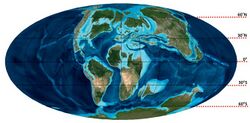Earth:Turonian
| Turonian | |
|---|---|
| 93.9 – 89.8 ± 0.3 Ma | |
 Paleogeography of the late Turonian (90 Ma), showing the high sea level at the time | |
| Chronology | |
| Etymology | |
| Name formality | Formal |
| Usage information | |
| Celestial body | Earth |
| Regional usage | Global (ICS) |
| Time scale(s) used | ICS Time Scale |
| Definition | |
| Chronological unit | Age |
| Stratigraphic unit | Stage |
| Time span formality | Formal |
| Lower boundary definition | FAD of the Ammonite Watinoceras devonense |
| Lower boundary GSSP | Rock Canyon, Colorado, United States [ ⚑ ] 38°16′56″N 104°43′39″W / 38.2822°N 104.7275°W |
| GSSP ratified | September 2003[2] |
| Upper boundary definition | Not formally defined |
| Upper boundary definition candidates | FAD of the Inoceramid Bivalve Cremnoceramus rotundatus |
| Upper boundary GSSP candidate section(s) | |
The Turonian is, in the ICS' geologic timescale, the second age in the Late Cretaceous Epoch, or a stage in the Upper Cretaceous Series. It spans the time between 93.9 ± 0.8 Ma and 89.8 ± 1 Ma (million years ago). The Turonian is preceded by the Cenomanian Stage and underlies the Coniacian Stage.[3]
At the beginning of the Turonian an oceanic anoxic event (OAE 2) took place, also referred to as the Cenomanian-Turonian boundary event or the "Bonarelli Event". Sea level fall took place in the latter part of the Turonian from the highstand at the beginning of the Turonian.[4]
Stratigraphic definition

The Turonian (French: Turonien) was defined by the France paleontologist Alcide d'Orbigny (1802–1857) in 1842. Orbigny named it after the French city of Tours in the region of Touraine (department Indre-et-Loire), which is the original type locality.
The base of the Turonian Stage is defined as the place where the ammonite species Watinoceras devonense first appears in the stratigraphic column. The official reference profile (the GSSP) for the base of the Turonian is located in the Rock Canyon anticline near Pueblo, Colorado (United States, coordinates: 38° 16' 56" N, 104° 43' 39" W).[5]
The top of the Turonian Stage (the base of the Coniacian) is defined as the place in the stratigraphic column where the inoceramid bivalve species Cremnoceramus rotundatus first appears.
Subdivision
The Turonian is sometimes subdivided in Lower/Early, Middle and Upper/Late substages or subages. In the Tethys domain, it contains the following ammonite biozones:
- zone of Subprionocyclus neptuni (in the Upper Turonian)
- zone of Collignoniceras woollgari (in the Middle Turonian)
- zone of Mammites nodosoides
- zone of Watinoceras coloradoense or Watinoceras devonense (last two both in the Lower Turonian)
Other important index fossils are species of the inoceramid genus Inoceramus (I. schloenbachi, I. lamarcki and I. labiatus). Inoceramids are bivalve Mollusca related to today's mussels.
References
- ↑ Super User. "ICS - Chart/Time Scale". http://www.stratigraphy.org/index.php/ics-chart-timescale.
- ↑ Kennedy, W. J.; I. Walaszczyk; W. A. Cobban (2005). "The Global Boundary Stratotype Section and Point for the base of the Turonian Stage of the Cretaceous: Pueblo, Colorado, U.S.A.". Episodes 28 (2): 93–104. doi:10.18814/epiiugs/2005/v28i2/003. http://www.stratigraphy.org/GSSP/file14.pdf.
- ↑ See Gradstein et al. (2004) for a detailed description of the ICS' timescale
- ↑ Wiese, Frank; Kröger, Björn (January 1998). "Evidence for a shallowing event in the Upper Turonian (Cretaceous) Mytiloides scupini Zone of northern Germany". Acta Palaeontologica Polonica 48 (3): 265-284. https://www.researchgate.net/publication/279594550_Evidence_for_a_shallowing_event_in_the_Upper_Turonian_Cretaceous_Mytiloides_scupini_Zone_of_northern_Germany. Retrieved 15 December 2023.
- ↑ The GSSP was established by Kennedy et al. (2005)
Literature
- Gradstein, F.M.; Ogg, J.G. & Smith, A.G.; 2004: A Geologic Time Scale 2004, Cambridge University Press .
- Kennedy, W.J.; Walaszczyk, I. & Cobban, W.A.; 2005: The Global Boundary Stratotype Section and Point for the base of the Turonian Stage of the Cretaceous: Pueblo, Colorado, U.S.A., Episodes 28(2): pp 93–104.
External links
- GeoWhen Database - Turonian
- Late Cretaceous timescale, at the website of the subcommission for stratigraphic information of the ICS
- Stratigraphic charts of the Cretaceous: [1] and [2], at the website of Norges Network of offshore records of geology and stratigraphy
- Turonian Microfossils: 48 images of Foraminifera
 |

